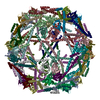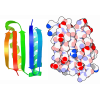+ データを開く
データを開く
- 基本情報
基本情報
| 登録情報 | データベース: PDB / ID: 7xm1 | |||||||||||||||
|---|---|---|---|---|---|---|---|---|---|---|---|---|---|---|---|---|
| タイトル | Cryo-EM structure of mTIP60-Ba (metal-ion induced TIP60 (K67E) complex with barium ions | |||||||||||||||
 要素 要素 | TIP60 K67E mutant | |||||||||||||||
 キーワード キーワード | DE NOVO PROTEIN / Artificial designed protein complex / Protein cage / Protein nanoparticle / Metal-induced protein assembly / Protein metal complex | |||||||||||||||
| 機能・相同性 | :  機能・相同性情報 機能・相同性情報 | |||||||||||||||
| 生物種 | synthetic construct (人工物) | |||||||||||||||
| 手法 | 電子顕微鏡法 / 単粒子再構成法 / クライオ電子顕微鏡法 / 解像度: 3.96 Å | |||||||||||||||
 データ登録者 データ登録者 | Ohara, N. / Kawakami, N. / Arai, R. / Adachi, N. / Moriya, T. / Kawasaki, M. / Miyamoto, K. | |||||||||||||||
| 資金援助 |  日本, 4件 日本, 4件
| |||||||||||||||
 引用 引用 |  ジャーナル: J Am Chem Soc / 年: 2023 ジャーナル: J Am Chem Soc / 年: 2023タイトル: Reversible Assembly of an Artificial Protein Nanocage Using Alkaline Earth Metal Ions. 著者: Naoya Ohara / Norifumi Kawakami / Ryoichi Arai / Naruhiko Adachi / Toshio Moriya / Masato Kawasaki / Kenji Miyamoto /  要旨: Protein nanocages are of increasing interest for use as drug capsules, but the encapsulation and release of drug molecules at appropriate times require the reversible association and dissociation of ...Protein nanocages are of increasing interest for use as drug capsules, but the encapsulation and release of drug molecules at appropriate times require the reversible association and dissociation of the nanocages. One promising approach to addressing this challenge is the design of metal-dependent associating proteins. Such designed proteins typically have Cys or His residues at the protein surface for connecting the associating proteins through metal-ion coordination. However, Cys and His residues favor interactions with soft and borderline metal ions, such as Au and Zn, classified by the hard and soft acids and bases concept, restricting the types of metal ions available to drive association. Here, we show the alkaline earth (AE) metal-dependent association of the recently designed artificial protein nanocage TIP60, which is composed of 60-mer fusion proteins. The introduction of a Glu (hard base) mutation to the fusion protein (K67E mutant) prevented the formation of the 60-mer but formed the expected cage structure in the presence of Ca, Sr, or Ba ions (hard acids). Cryogenic electron microscopy (cryo-EM) analysis indicated a Ba ion at the interface of the subunits. Furthermore, we demonstrated the encapsulation and release of single-stranded DNA molecules using this system. Our results provide insights into the design of AE metal-dependent association and dissociation mechanisms for proteins. #1: ジャーナル: Angew Chem Int Ed Engl / 年: 2018 タイトル: Design of Hollow Protein Nanoparticles with Modifiable Interior and Exterior Surfaces. 著者: Norifumi Kawakami / Hiroki Kondo / Yuki Matsuzawa / Kaoru Hayasaka / Erika Nasu / Kenji Sasahara / Ryoichi Arai / Kenji Miyamoto /  要旨: Protein-based nanoparticles hold promise for a broad range of applications. Here, we report the production of a uniform anionic hollow protein nanoparticle, designated TIP60, which spontaneously ...Protein-based nanoparticles hold promise for a broad range of applications. Here, we report the production of a uniform anionic hollow protein nanoparticle, designated TIP60, which spontaneously assembles from a designed fusion protein subunit based on the geometric features of polyhedra. We show that TIP60 tolerates mutation and both its interior and exterior surfaces can be chemically modified. Moreover, TIP60 forms larger structures upon the addition of a cationic protein. Therefore, TIP60 can be used as a modifiable nano-building block for further molecular assembly. #2:  ジャーナル: Chem Commun (Camb) / 年: 2021 ジャーナル: Chem Commun (Camb) / 年: 2021タイトル: Icosahedral 60-meric porous structure of designed supramolecular protein nanoparticle TIP60. 著者: Junya Obata / Norifumi Kawakami / Akihisa Tsutsumi / Erika Nasu / Kenji Miyamoto / Masahide Kikkawa / Ryoichi Arai /  要旨: Supramolecular protein nanoparticles and nanocages have potential in a broad range of applications. Recently, we developed a uniform supramolecular protein nanoparticle, TIP60, symmmetrically self- ...Supramolecular protein nanoparticles and nanocages have potential in a broad range of applications. Recently, we developed a uniform supramolecular protein nanoparticle, TIP60, symmmetrically self-assembled from fusion proteins of a pentameric Sm-like protein and a dimeric MyoX-coil domain. Herein, we report the icosahedral 60-meric structure of TIP60 solved using single-particle cryo-electron microscopy. Interestingly, the structure revealed 20 regular-triangle-like pores on the surface. TIP60 and its mutants have many modifiable sites on their exterior and interior surfaces. The TIP60 architecture will be useful in the development of biomedical and biochemical nanoparticles/nanocages for future applications. | |||||||||||||||
| 履歴 |
|
- 構造の表示
構造の表示
| 構造ビューア | 分子:  Molmil Molmil Jmol/JSmol Jmol/JSmol |
|---|
- ダウンロードとリンク
ダウンロードとリンク
- ダウンロード
ダウンロード
| PDBx/mmCIF形式 |  7xm1.cif.gz 7xm1.cif.gz | 1.3 MB | 表示 |  PDBx/mmCIF形式 PDBx/mmCIF形式 |
|---|---|---|---|---|
| PDB形式 |  pdb7xm1.ent.gz pdb7xm1.ent.gz | 表示 |  PDB形式 PDB形式 | |
| PDBx/mmJSON形式 |  7xm1.json.gz 7xm1.json.gz | ツリー表示 |  PDBx/mmJSON形式 PDBx/mmJSON形式 | |
| その他 |  その他のダウンロード その他のダウンロード |
-検証レポート
| 文書・要旨 |  7xm1_validation.pdf.gz 7xm1_validation.pdf.gz | 1.8 MB | 表示 |  wwPDB検証レポート wwPDB検証レポート |
|---|---|---|---|---|
| 文書・詳細版 |  7xm1_full_validation.pdf.gz 7xm1_full_validation.pdf.gz | 1.8 MB | 表示 | |
| XML形式データ |  7xm1_validation.xml.gz 7xm1_validation.xml.gz | 132 KB | 表示 | |
| CIF形式データ |  7xm1_validation.cif.gz 7xm1_validation.cif.gz | 224.6 KB | 表示 | |
| アーカイブディレクトリ |  https://data.pdbj.org/pub/pdb/validation_reports/xm/7xm1 https://data.pdbj.org/pub/pdb/validation_reports/xm/7xm1 ftp://data.pdbj.org/pub/pdb/validation_reports/xm/7xm1 ftp://data.pdbj.org/pub/pdb/validation_reports/xm/7xm1 | HTTPS FTP |
-関連構造データ
| 関連構造データ |  33289MC M: このデータのモデリングに利用したマップデータ C: 同じ文献を引用 ( |
|---|---|
| 類似構造データ | 類似検索 - 機能・相同性  F&H 検索 F&H 検索 |
| その他のデータベース |
- リンク
リンク
- 集合体
集合体
| 登録構造単位 | 
|
|---|---|
| 1 |
|
- 要素
要素
| #1: タンパク質 | 分子量: 17794.160 Da / 分子数: 60 / 由来タイプ: 組換発現 / 由来: (組換発現) synthetic construct (人工物) / 遺伝子: TIP60 / Variant: K67E / プラスミド: pETDuet-1 / 発現宿主:  #2: 化合物 | ChemComp-BA / 研究の焦点であるリガンドがあるか | Y | |
|---|
-実験情報
-実験
| 実験 | 手法: 電子顕微鏡法 |
|---|---|
| EM実験 | 試料の集合状態: PARTICLE / 3次元再構成法: 単粒子再構成法 |
- 試料調製
試料調製
| 構成要素 | 名称: mTIP60-Ba / タイプ: COMPLEX 詳細: metal-ion induced TIP60 (truncated icosahedral protein composed of 60-mer fusion proteins) complexed with barium ions Entity ID: #1 / 由来: RECOMBINANT | ||||||||||||||||||||
|---|---|---|---|---|---|---|---|---|---|---|---|---|---|---|---|---|---|---|---|---|---|
| 分子量 | 値: 1.074 MDa / 実験値: YES | ||||||||||||||||||||
| 由来(天然) | 生物種: synthetic construct (人工物) | ||||||||||||||||||||
| 由来(組換発現) | 生物種:  | ||||||||||||||||||||
| 緩衝液 | pH: 8 | ||||||||||||||||||||
| 緩衝液成分 |
| ||||||||||||||||||||
| 試料 | 濃度: 5 mg/ml / 包埋: NO / シャドウイング: NO / 染色: NO / 凍結: YES | ||||||||||||||||||||
| 試料支持 | 詳細: The grid was washed by acetone prior to use. / グリッドの材料: COPPER / グリッドのサイズ: 300 divisions/in. / グリッドのタイプ: Quantifoil R1.2/1.3 | ||||||||||||||||||||
| 急速凍結 | 装置: FEI VITROBOT MARK IV / 凍結剤: ETHANE / 湿度: 100 % / 凍結前の試料温度: 291 K / 詳細: Blotting time was 15 seconds (blot force 5) |
- 電子顕微鏡撮影
電子顕微鏡撮影
| 実験機器 |  モデル: Talos Arctica / 画像提供: FEI Company |
|---|---|
| 顕微鏡 | モデル: FEI TALOS ARCTICA |
| 電子銃 | 電子線源:  FIELD EMISSION GUN / 加速電圧: 200 kV / 照射モード: FLOOD BEAM FIELD EMISSION GUN / 加速電圧: 200 kV / 照射モード: FLOOD BEAM |
| 電子レンズ | モード: BRIGHT FIELD / 倍率(公称値): 120000 X / 最大 デフォーカス(公称値): 2500 nm / 最小 デフォーカス(公称値): 1000 nm / Cs: 2.7 mm / C2レンズ絞り径: 50 µm |
| 試料ホルダ | 凍結剤: NITROGEN |
| 撮影 | 平均露光時間: 66.42 sec. / 電子線照射量: 50 e/Å2 / 検出モード: COUNTING フィルム・検出器のモデル: FEI FALCON III (4k x 4k) 撮影したグリッド数: 1 / 実像数: 2206 |
| 画像スキャン | 横: 4096 / 縦: 4096 |
- 解析
解析
| ソフトウェア |
| ||||||||||||||||||||||||||||||||||||||||||||
|---|---|---|---|---|---|---|---|---|---|---|---|---|---|---|---|---|---|---|---|---|---|---|---|---|---|---|---|---|---|---|---|---|---|---|---|---|---|---|---|---|---|---|---|---|---|
| EMソフトウェア |
| ||||||||||||||||||||||||||||||||||||||||||||
| CTF補正 | タイプ: PHASE FLIPPING AND AMPLITUDE CORRECTION | ||||||||||||||||||||||||||||||||||||||||||||
| 粒子像の選択 | 選択した粒子像数: 113155 | ||||||||||||||||||||||||||||||||||||||||||||
| 対称性 | 点対称性: I (正20面体型対称) | ||||||||||||||||||||||||||||||||||||||||||||
| 3次元再構成 | 解像度: 3.96 Å / 解像度の算出法: FSC 0.143 CUT-OFF / 粒子像の数: 61251 / アルゴリズム: FOURIER SPACE / クラス平均像の数: 1 / 対称性のタイプ: POINT | ||||||||||||||||||||||||||||||||||||||||||||
| 原子モデル構築 | B value: 22.77 / プロトコル: OTHER / 空間: REAL / Target criteria: Correlation coefficient | ||||||||||||||||||||||||||||||||||||||||||||
| 原子モデル構築 | PDB-ID: 7EQ9 PDB chain-ID: A / Accession code: 7EQ9 / Pdb chain residue range: 2-136 / Source name: PDB / タイプ: experimental model | ||||||||||||||||||||||||||||||||||||||||||||
| 精密化 | 交差検証法: NONE 立体化学のターゲット値: GeoStd + Monomer Library + CDL v1.2 | ||||||||||||||||||||||||||||||||||||||||||||
| 原子変位パラメータ | Biso mean: 22.84 Å2 | ||||||||||||||||||||||||||||||||||||||||||||
| 拘束条件 |
|
 ムービー
ムービー コントローラー
コントローラー




 PDBj
PDBj


